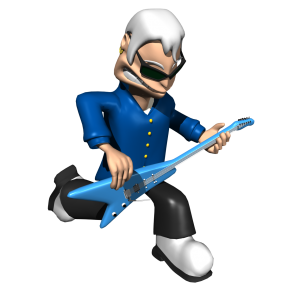Before you do anything else, read the rest of this article. It will be your shield against the advice you might get from a salesman at your local music store, or from some other audio experts. Here are the five secrets:
You DON’T need to lay down a bunch of money to get started.
Try this just for fun. Walk into your nearest musical instrument store (the kind that has a “recording” department) and ask them what you would need to get started recording audio from home. My guess is that you will be told you need a condenser mic, cables, mic stand, computer interface and special software; all of which will end up costing at least $500, but more likely, over $1000, and you still won’t know how to use it! The only other option, you’re told, is to go to a commercial recording studio, which will cost around $50 per hour plus the hassle of getting there with all the stuff (or all the people if you’re in a band) you’ll need. Most people believe those are their only two options. Well the truth is you probably don’t need to spend a dime on gear, OR a studio. All you need is a computer with a sound card (just the onboard one will do for starters), the microphone that probably came with your computer (which you can get for $4.00 at Target if you didn’t get one), headphones (the kind you use with your mp3 player will do), and an internet connection. I’m betting most folks have all that stuff RIGHT NOW. It just takes a little knowledge about how to get the most out of what you have….which brings me to the next point:
Knowledge is far more important than gear.
Fact: you can still make bad recordings with top-notch (read: “expensive”) gear. This is extremely common. Just pick up a copy of “Recording Magazine” and look at the “Readers Tapes” section some time if you want to see for yourself. Their reviewer is constantly dumbfounded at the great recordings that come in with cheap-to-modest gear, as well as the crappy recordings that are produced on high-end gear costing up to $10,000 (or more) most of the time! If you would like to hear a real-world example of this, listen to our podcast here. Fact: now that the technology is available to virtually anyone with a computer, the world is flooded with really terrible-sounding audio. That’s because most people (and I do mean like 80-90 percent here) don’t know the basic principles of audio recording, mixing and producing. With so many amateurs cranking out audio, the only real discriminators that will set YOU apart from the rest are “content” (your song, your podcast, etc.) and “know-how.” Fact: if you’re just starting out, and you have $300, you will produce better recordings after spending the $$ on knowledge than if you buy any equipment or software..
You don’t need to know HOW a television works in order to learn to USE it.
What? Said another way, you don’t have to know how to rebuild an engine in order to drive a car, do you? What you DO need to be taught can be learned very quickly (about a minute in the case of a TV). You could go your entire life and not know what a “catalytic converter” is, and it wouldn’t stop you driving the car. Heck, I’ve been watching television for 35 (or moreJ) years, and I STILL don’t know what a “cathode ray tube” really was. I didn’t even notice when you didn’t need one any more! The same is true for recording. Having gone through this as a beginner, I can tell you that MANY of the “experts” you’ll find on the newsgroups or forums will offer beginners some version of the following statement: “You can’t really learn recording overnight, or from books; you just have to do it over and over again for years to really learn it.” This is simply not true, and it stops a lot of people trying. It’s a little like saying “you can’t really understand how a TV works unless you go to TV-repair school, or at least have an electrical engineering degree.” That’s true, but I don’t NEED to understand all that stuff! I just want to change the channels! It will depend to large degree on what kind of recording you are trying to do (spoken-word, music multi-tracking for a CD project, or full-on CD mastering), but a large percentage of folks can learn to do ALL they NEED TO from in less than an hour from the right teacher. Many beginners take one look at, say, a mixing board (or its virtual counter-part), get information overload, and run screaming from the room. Heck I still do it after 30 years in this business! The bottom-line truth is…you really only have to learn 4 or 5 of those 80 or 90 buttons and scary commands to do what you need to do to start! Then as you choose to go deeper down the rabbit hole, you’ll have to learn maybe 15 more…seriously! I’ve engineered hundreds (probably thousands) of audio projects over the last 30 years, and I estimate I probably only know about 1/5th of what my programs and gear can do!
You DON’T Need a Mac!
Oh, this one goes back to the 80s. When every-day people started to buy computers (yes, kids…there was a time when households did not have a computer! And a short time before that, they didn’t even have televisions! Shock, Horror….sorry, I’m better now), the early Macs had some built-in features that made them better-suited to music-production. But over the years, things have evened out, and the recording landscape is about 50/50 on the issue. It’s like Pepsi and Coke. Some people prefer on over the other, but one is not INHERENTLY better than the other overall. Our tutorials are geared toward teaching skills REGARDLESS of the OS. But DON’T be talked into buying a MAC for audio just because a salesman tells you their better. It’s just not true anymore.
You Don’t Need “Pro Tools”
This is another myth that persists from the “old days.” There was a time, in the late 80s, when the software program called “Pro Tools” was only available for the Mac. Early versions for PC were often unstable. That was pretty-much fixed by the mid-late 90s. But since Pro Tools was marketed directly to the professional market from the start, on the Mac, it sort of became standard to associate “good” recording software with both Pro Tools and the Mac. Pro Tools is still regarded as probably the most commonly-used audio software in the world. But in the 21st century, “common” does not necessarily mean “better,” and it ABSOLUTELY does not mean “mandatory.” In order to use Pro Tools, you not only need the software, but also very specific hardware as well! The program will not work without one of several approved hardware interfaces. At the time of this writing, the least expensive Pro Tools system available is “Pro Tools M-Powered,” combined with the M-Audio Fast Track Pro interface. Total cost: $450. Compare that with the minimum cost of gear/software I mentioned above, which comes out to…..hmmmm…let me think….oh yeah, $0.00! Will that budget get you EVERYTHING Pro Tools can get you, in terms of capability or quality? No. But it will get most folks what they NEED, right NOW. Then when you need the next steps up in features and capability, there are incremental steps to climb (like $50 for the first 3 jumps) so you don’t pay for more than your need. Why buy a Lexus when you only need a bicycle? One day you may want a Pro Tools system. But for Pete’s sake, don’t dive right in with Pro Tools! Now go forth and record! And start today…without the 2nd mortgage:).
Cheers!

 By the time you finish reading this article, you will have a functioning multi-track digital audio pc recording studio without having to spend any money. Interested? Read on!
By the time you finish reading this article, you will have a functioning multi-track digital audio pc recording studio without having to spend any money. Interested? Read on!